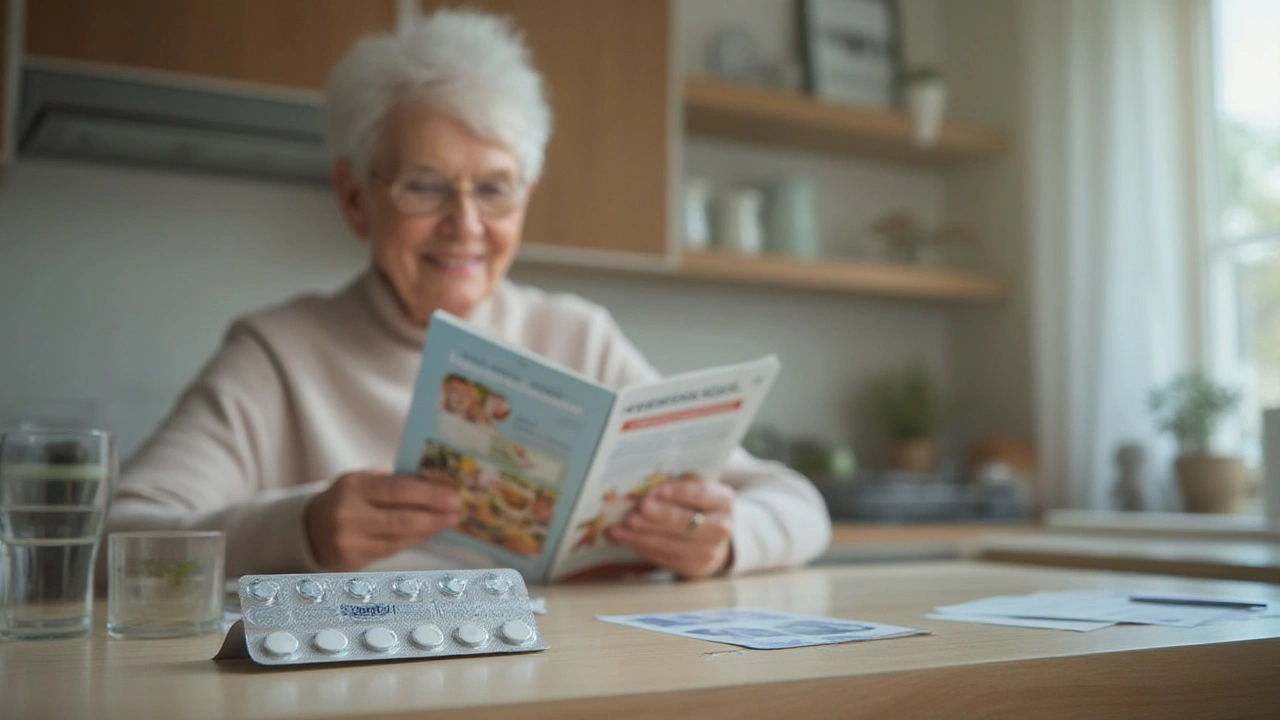High blood pressure often hides in plain sight, quietly putting millions at risk every day. You can feel totally fine—until, suddenly, you’re not. Sartel, a medication prescribed for high blood pressure, sits on countless medicine shelves, but most folks don’t really know how it works, why it’s prescribed, or what’s actually happening inside their bodies when they take it. If you or someone close to you has ever stared at a pill bottle marked 'Sartel,' you’ve probably wondered: What does this stuff really do, and what should I watch out for?
What is Sartel and How Does it Work?
Sartel is the brand name for telmisartan, a type of medicine called an angiotensin II receptor blocker (ARB). Doctors hand it out mostly to help control high blood pressure (hypertension), but it also pops up on the prescription list for those with type 2 diabetes who need to protect their kidneys from harm. By blocking angiotensin II—a hormone in your body that tightens up blood vessels—Sartel helps those vessels relax and open up. When that happens, your blood can flow more easily, so your heart doesn’t have to pump as hard, and your blood pressure drops to a safer level.
Now, telmisartan has actually been used in the UK and worldwide since the early 2000s. Researchers have found that lowering blood pressure with ARBs like Sartel reduces the risk of strokes, heart attacks, and kidney issues. What’s neat is it often works when other meds haven’t managed to bring those numbers down. Telmisartan can also be a good choice if you get annoying coughs from certain blood pressure drugs called ACE inhibitors—Sartel usually doesn’t give people that problem.
One thing people like about Sartel is that you only have to take it once a day, usually at the same time each day. It comes in several strengths—20 mg, 40 mg, and 80 mg—so doctors can tailor your dose right to your needs. And yes, it’s just a single pill to swallow, so it’s easier to remember.
People often ask how quickly Sartel starts doing its job. The answer? It starts to lower blood pressure within about three hours, but to feel the full effect, it may take a couple of weeks of steady use. That’s normal—it’s not instant coffee, it’s more of a slow and steady fix.
Here’s a quick look at how Sartel acts in your body:
- Blocks angiotensin II to relax blood vessels
- Lowers resistance, making blood flow easier
- Reduces the stress on your heart
- Provides extra kidney protection if you have certain health issues
It’s not a cure for high blood pressure, but it doesn’t take a back seat when it comes to keeping things in check. When it comes to efficacy, studies in the National Institute for Health and Care Excellence (NICE) guidelines show Sartel is just as good as top-selling ARBs like losartan or valsartan. What makes it especially handy is the low rate of side effects that actually bother people enough to stop taking the med.
If you’re wondering if Sartel can be used alone or with other meds—yes, it gets combined with diuretics (like hydrochlorothiazide) a lot. That combo packs a bigger punch for those stubborn blood pressure readings. And for diabetic patients, keeping that blood pressure in line can make a world of difference for kidney health.

Benefits, Side Effects, and What to Expect
People taking Sartel often say they appreciate that it just fits into their routine, especially compared to meds that need to be taken more than once a day. You can have it with or without food, so no need to change up your eating habits or set tons of reminders throughout the day. That’s a relief for anyone who already feels like life is ruled by pill times.
But no medicine works in a vacuum, and Sartel does bring some possible side effects. Most folks handle it just fine, but here’s a list of what tends to show up, according to NHS records and recent UK clinical audits:
- Dizziness, especially when you first start—best to get up slowly until your body adjusts
- Back pain
- Sinus congestion or stuffy nose
- Feeling tired or weak in the early days
- Rarely, a rash or stomach discomfort
If you notice swelling in your face, lips, or throat, or have trouble breathing, get help quick—those can be signs of an allergic reaction. For most people, though, minor side effects fade after the first few weeks. Drinking enough water helps, and a consistent sleep routine can keep the worst fatigue away.
One thing to watch: Sartel can increase potassium levels in your blood. That’s not something you’ll feel right away, but if you suddenly get muscle weakness or abnormal heartbeats, ring up your GP. If you’re taking potassium supplements or salt substitutes with potassium, let your doctor know—they may need to adjust your routine.
If you’ve got kidney or liver problems, doctors might start you on a lower dose and check your blood more often. Sartel isn’t usually recommended during pregnancy or breastfeeding, because of risks for the baby. There’s also a warning for folks who mix booze with their blood pressure pills: alcohol can make you feel even dizzier, so moderation is key.
Some tips that help many people using Sartel:
- Take your dose at the same time daily for best results.
- Use a pill organiser or set a phone reminder if you’re forgetful.
- Check your blood pressure at home if you can—local pharmacies in the UK often offer free checks.
- Let your doctor know about any new medicines or supplements, including over-the-counter things like ibuprofen, which can mess with your kidneys.
Wondering when you’ll know if Sartel’s making a difference? Blood pressure numbers can start to fall within the first week, but for proper control and feeling the full benefit, stick with it for a full month. Don’t stop suddenly—this can make your blood pressure shoot up again. If you notice strange side effects, don’t stop on your own; check in with your GP. Many people swap in and out of different ARBs before landing on the one that feels right, which is perfectly normal.
By sticking to a routine and checking in with your healthcare team, you’ll give yourself the best chance at keeping blood pressure where it should be, and dodging those long-term problems that can sneak up on you if numbers stay high. Sartel isn’t magic, but with the right habits, it’s an effective tool in the fight against hypertension and kidney trouble.

Living With Sartel: Day-to-Day Tips and Real-World Insights
Managing high blood pressure isn’t just about swallowing a tablet and carrying on. The lifestyle tweaks you make alongside Sartel turn it from 'just a pill' into real protection for your heart and kidneys. Take Bristol’s own Dr. Gwen Thomas, who says, “No blood pressure drug can do its best unless you’re looking after yourself in other ways—think easy daily walks, less salt at mealtimes, and a few less pints at the pub.” She’s spot on.
So, what are some ways to help Sartel do the heavy lifting?
- Keep an eye on your salt intake. Switch out salty snacks for fruit, nuts, or a banana.
- Move a bit each day. A brisk walk—even 20 minutes around the block—makes a difference.
- Stay hydrated, but check with your doctor about how much water is right for you if you’ve got kidney issues.
- Stick to regular check-ups—your GP might want to keep tabs on your blood, just to be sure potassium and kidney numbers stay safe.
- Stop smoking. It sounds obvious, but smoking sends your blood pressure up even if you’re on strong meds.
Don’t be afraid to ask questions if you’re unsure. UK pharmacy teams are trained up on ARBs and can give quick advice about missed doses or tricky side effects. Most people have forgotten a dose at some point—if that’s you, take the tablet as soon as you remember that day. If you go a whole day without, just skip to the next dose. Doubling up to 'catch up' is a bad idea—it can drop your blood pressure too far and leave you dizzy as heck.
Food-wise, talk to your GP about grapefruit. It isn’t a big risk with Sartel compared to some other meds, but checking is a good call. And with all blood pressure drugs, things like licorice sweets, certain herbal teas, or even heavy caffeine intake can stir up trouble—always ask before making changes.
People often worry about driving. At normal doses, Sartel doesn’t mess with your coordination. Still, if you’re new to the pill and feel lightheaded, steer clear of your car until you feel back to normal. The DVLA in the UK doesn’t restrict driving for most blood pressure meds unless you’ve had serious blackouts.
It’s also worth mentioning how common Sartel actually is: thousands of prescriptions are filled every month in the UK alone, according to NHS Digital stats from this spring. Most users are over 40 and on at least one other medication—high blood pressure tends to run in crowds with cholesterol and diabetes. Since Sartel can be combined with other heart drugs, your GP will check for interaction risks. They might need to adjust your dose if you add something new.
If you’re set to travel, keep a note from your doctor and your meds in the original packaging—it stops hassles at airport security. Time zone changes? Try to stick as close as you can to your usual schedule; set alarms on your phone and carry a small pill box in your carry-on bag. Missing a dose here and there isn’t the end of the world, but consistency counts.
There’s science behind what you’re feeling, too. According to a multi-country study published in The Lancet last year, telmisartan—especially when combined with good sleep, exercise, and less salt—led to fewer heart attacks compared to lifestyle changes or medication alone. It’s a team effort, really.
Relying on Sartel or any high blood pressure medication is not a sign of weakness—it’s preventive care that can give you more years free of hospital visits or scary complications. So many people keep quiet about their pills, but if we talked about blood pressure as much as we do about steps on our watches, you’d see just how many friends and family members are actually on ARBs like Sartel. You’re not alone in this.
In the end, living with Sartel means stacking up small, daily wins. You’re swallowing a tablet, but you’re also raising your odds of dodging heart and kidney trouble. Sticking to your routine, making a few sensible home changes, and keeping the lines open with your doctor—these are the things that give Sartel its real power. It’s more than just a pill; it’s a piece of the puzzle that helps keep you feeling good and living life on your own terms.







Brandon Benzi
July 11, 2025 AT 14:17Abhay Chitnis
July 12, 2025 AT 17:16Robert Spiece
July 12, 2025 AT 22:33Meanwhile, the real solution - reducing sodium, walking, sleeping - is too inconvenient to be monetized. So we sell you a $120 monthly ritual wrapped in a glossy pamphlet and call it 'healthcare'.
It’s not a cure. It’s a subscription.
Vivian Quinones
July 13, 2025 AT 02:54Eric Pelletier
July 14, 2025 AT 22:02Unlike ACEi, it doesn’t increase bradykinin, so no dry cough. That’s why it’s preferred in patients with ACEi intolerance.
Also, avoid NSAIDs with it - they can blunt the antihypertensive effect and increase renal risk. Check your eGFR and K+ every 3-6 weeks initially.
Marshall Pope
July 15, 2025 AT 19:19Nonie Rebollido
July 17, 2025 AT 07:25Agha Nugraha
July 18, 2025 AT 01:53Andy Smith
July 19, 2025 AT 11:50Rekha Tiwari
July 21, 2025 AT 08:04Leah Beazy
July 21, 2025 AT 09:28John Villamayor
July 21, 2025 AT 17:44Jenna Hobbs
July 22, 2025 AT 00:35Ophelia Q
July 22, 2025 AT 23:04Elliott Jackson
July 24, 2025 AT 09:20McKayla Carda
July 25, 2025 AT 22:33Christopher Ramsbottom-Isherwood
July 26, 2025 AT 07:44